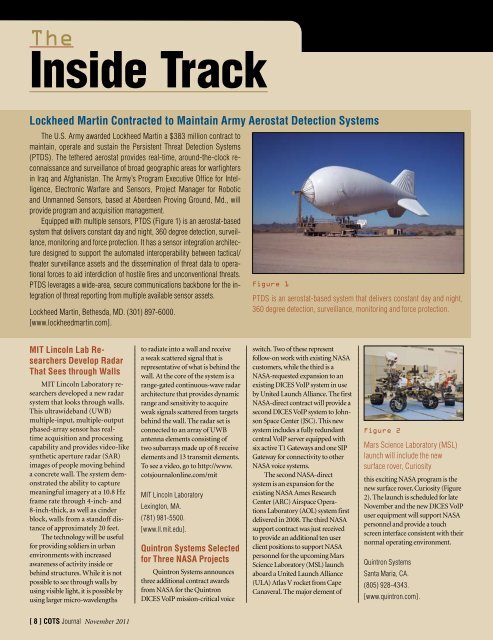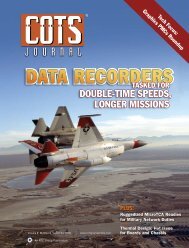Inrush Current Control Technology Boosts Power Converter Reliability
Inrush Current Control Technology Boosts Power Converter Reliability
Inrush Current Control Technology Boosts Power Converter Reliability
You also want an ePaper? Increase the reach of your titles
YUMPU automatically turns print PDFs into web optimized ePapers that Google loves.
The<br />
Inside Track<br />
Lockheed Martin Contracted to Maintain Army Aerostat Detection Systems<br />
The U.S. Army awarded Lockheed Martin a $383 million contract to<br />
maintain, operate and sustain the Persistent Threat Detection Systems<br />
(PTDS). The tethered aerostat provides real-time, around-the-clock reconnaissance<br />
and surveillance of broad geographic areas for warfighters<br />
in Iraq and Afghanistan. The Army’s Program Executive Office for Intelligence,<br />
Electronic Warfare and Sensors, Project Manager for Robotic<br />
and Unmanned Sensors, based at Aberdeen Proving Ground, Md., will<br />
provide program and acquisition management.<br />
Equipped with multiple sensors, PTDS (Figure 1) is an aerostat-based<br />
system that delivers constant day and night, 360 degree detection, surveillance,<br />
monitoring and force protection. It has a sensor integration architecture<br />
designed to support the automated interoperability between tactical/<br />
theater surveillance assets and the dissemination of threat data to operational<br />
forces to aid interdiction of hostile fires and unconventional threats.<br />
PTDS leverages a wide-area, secure communications backbone for the integration<br />
of threat reporting from multiple available sensor assets.<br />
Lockheed Martin, Bethesda, MD. (301) 897-6000.<br />
[www.lockheedmartin.com].<br />
MIT Lincoln Lab Researchers<br />
Develop Radar<br />
That Sees through Walls<br />
MIT Lincoln Laboratory researchers<br />
developed a new radar<br />
system that looks through walls.<br />
This ultrawideband (UWB)<br />
multiple-input, multiple-output<br />
phased-array sensor has realtime<br />
acquisition and processing<br />
capability and provides video-like<br />
synthetic aperture radar (SAR)<br />
images of people moving behind<br />
a concrete wall. The system demonstrated<br />
the ability to capture<br />
meaningful imagery at a 10.8 Hz<br />
frame rate through 4-inch- and<br />
8-inch-thick, as well as cinder<br />
block, walls from a standoff distance<br />
of approximately 20 feet.<br />
The technology will be useful<br />
for providing soldiers in urban<br />
environments with increased<br />
awareness of activity inside or<br />
behind structures. While it is not<br />
possible to see through walls by<br />
using visible light, it is possible by<br />
using larger micro-wavelengths<br />
[ 8 ] COTS Journal November 2011<br />
to radiate into a wall and receive<br />
a weak scattered signal that is<br />
representative of what is behind the<br />
wall. At the core of the system is a<br />
range-gated continuous-wave radar<br />
architecture that provides dynamic<br />
range and sensitivity to acquire<br />
weak signals scattered from targets<br />
behind the wall. The radar set is<br />
connected to an array of UWB<br />
antenna elements consisting of<br />
two subarrays made up of 8 receive<br />
elements and 13 transmit elements.<br />
To see a video, go to http://www.<br />
cotsjournalonline.com/mit<br />
MIT Lincoln Laboratory<br />
Lexington, MA.<br />
(781) 981-5500.<br />
[www.ll.mit.edu].<br />
Quintron Systems Selected<br />
for Three NASA Projects<br />
Quintron Systems announces<br />
three additional contract awards<br />
from NASA for the Quintron<br />
DICES VoIP mission-critical voice<br />
Figure 1<br />
PTDS is an aerostat-based system that delivers constant day and night,<br />
360 degree detection, surveillance, monitoring and force protection.<br />
switch. Two of these represent<br />
follow-on work with existing NASA<br />
customers, while the third is a<br />
NASA-requested expansion to an<br />
existing DICES VoIP system in use<br />
by United Launch Alliance. The first<br />
NASA-direct contract will provide a<br />
second DICES VoIP system to Johnson<br />
Space Center (JSC). This new<br />
system includes a fully redundant<br />
central VoIP server equipped with<br />
six active T1 Gateways and one SIP<br />
Gateway for connectivity to other<br />
NASA voice systems.<br />
The second NASA-direct<br />
system is an expansion for the<br />
existing NASA Ames Research<br />
Center (ARC) Airspace Operations<br />
Laboratory (AOL) system first<br />
delivered in 2008. The third NASA<br />
support contract was just received<br />
to provide an additional ten user<br />
client positions to support NASA<br />
personnel for the upcoming Mars<br />
Science Laboratory (MSL) launch<br />
aboard a United Launch Alliance<br />
(ULA) Atlas V rocket from Cape<br />
Canaveral. The major element of<br />
Figure 2<br />
Mars Science Laboratory (MSL)<br />
launch will include the new<br />
surface rover, Curiosity<br />
this exciting NASA program is the<br />
new surface rover, Curiosity (Figure<br />
2). The launch is scheduled for late<br />
November and the new DICES VoIP<br />
user equipment will support NASA<br />
personnel and provide a touch<br />
screen interface consistent with their<br />
normal operating environment.<br />
Quintron Systems<br />
Santa Maria, CA.<br />
(805) 928-4343.<br />
[www.quintron.com].






